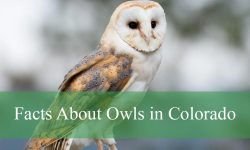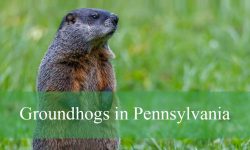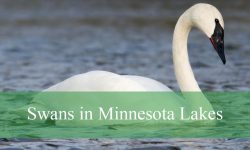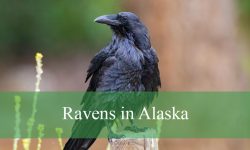Discover the vibrant world of Backyard Birds in California, where everyday moments outdoors can turn into exciting bird‐watching adventures. From the bold California Scrub‑Jay to the delicate Anna’s Hummingbird, our state’s backyards host an incredible diversity of feathered visitors year‑round.
Whether you live in the sun‑baked Central Valley, along the misty coast, or tucked into mountain foothills, Backyard Birds in California thrive in gardens, patios, and even city parks. With the right plants, feeders, and water features, you’ll create a welcoming habitat that brings these species right to your window.
In this guide, you’ll find clear photographs and identification tips for 35 Backyard Birds in California, along with notes on their behaviors, preferred foods, and seasonal patterns. Get ready to transform your outdoor space into a hotspot for birdlife and learn to recognize each visitor by sight and song!
Common Backyard Birds in California
California Scrub-Jay (Aphelocoma californica)
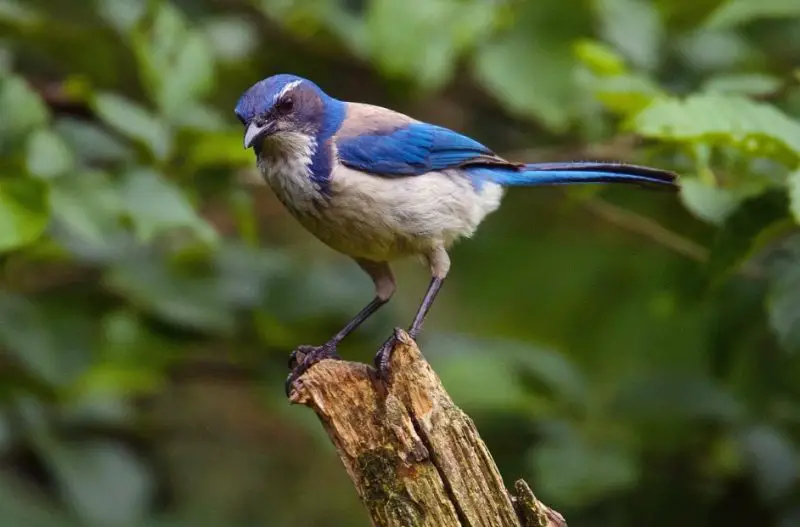
The California Scrub-Jay is a striking bird with bold blue wings, tail, and head, contrasted by a grayish back and underparts. It has a distinct white throat bordered by a blue necklace and a long, straight bill. Its sturdy build and expressive posture give it a commanding presence among backyard birds.
Easily recognized by its loud, scratchy calls, this jay is highly vocal and curious. It often perches openly on fences, trees, or rooftops, alert and always watching. California Scrub-Jays are known for their intelligence, even caching food like acorns and peanuts for later use. They can also be quite territorial, chasing off smaller birds from feeders.
This bird is widespread in California, thriving in oak woodlands, chaparral, and suburban neighborhoods. You’ll commonly see it in backyards with scattered trees, especially in Central and Southern California, where it readily visits bird feeders and searches for food on the ground.
Anna’s Hummingbird (Calypte anna)
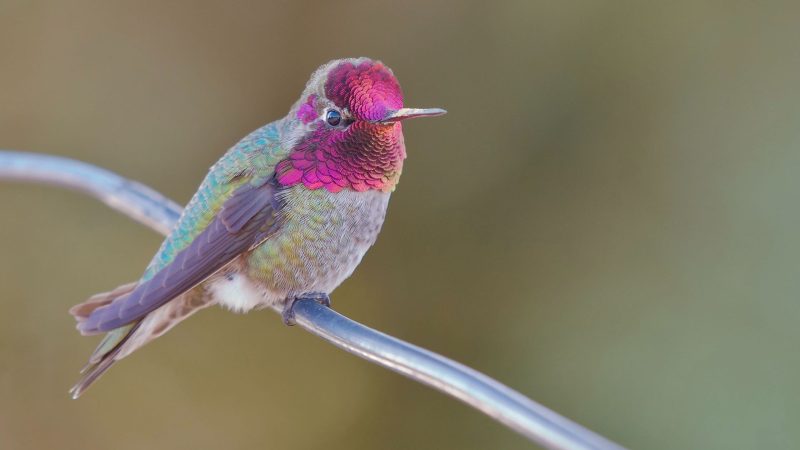
Anna’s Hummingbird is a dazzling little bird with shimmering green feathers and, in males, an iridescent pinkish-red throat known as a gorget. Females and juveniles are more subtly colored but still exhibit metallic green on the back and grayish undersides. Both sexes have long, slender bills suited for sipping nectar.
This hummingbird is unique for its year-round presence in California, even during winter. Males perform dramatic aerial dives during courtship displays, producing a sharp chirp from their tail feathers. They are fiercely territorial and will aggressively defend feeders or flower patches from other hummingbirds.
Anna’s Hummingbird is one of the most common backyard birds along the California coast and in urban gardens. It is especially abundant in areas with flowering plants, hummingbird feeders, or native shrubs from San Diego up to Northern California.
House Finch (Haemorhous mexicanus)
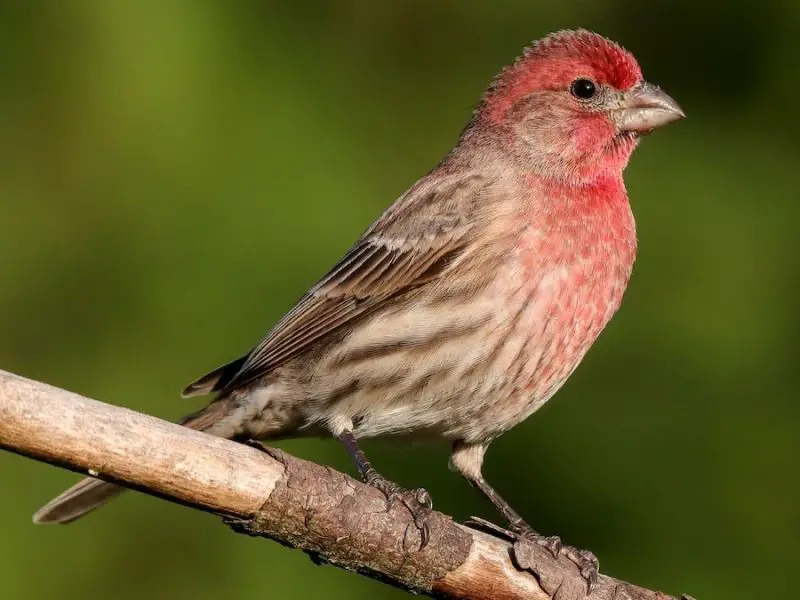
The House Finch is a small, chunky songbird with a conical beak and streaked plumage. Males are recognizable by their bright red heads, throats, and chests, while females are brown and heavily streaked throughout. Both sexes have relatively short wings and a long, notched tail.
These sociable birds are often seen in flocks at backyard feeders, where they favor sunflower seeds. Their cheerful, warbling song is a common sound in urban neighborhoods. House Finches are highly adaptable and tend to nest in hanging planters, eaves, or other sheltered man-made structures.
Widespread throughout California, the House Finch is one of the state’s most common backyard residents. You’ll find them in cities, suburbs, and rural areas alike—from Los Angeles and Sacramento to the Bay Area and inland valleys.
Lesser Goldfinch (Spinus psaltria)
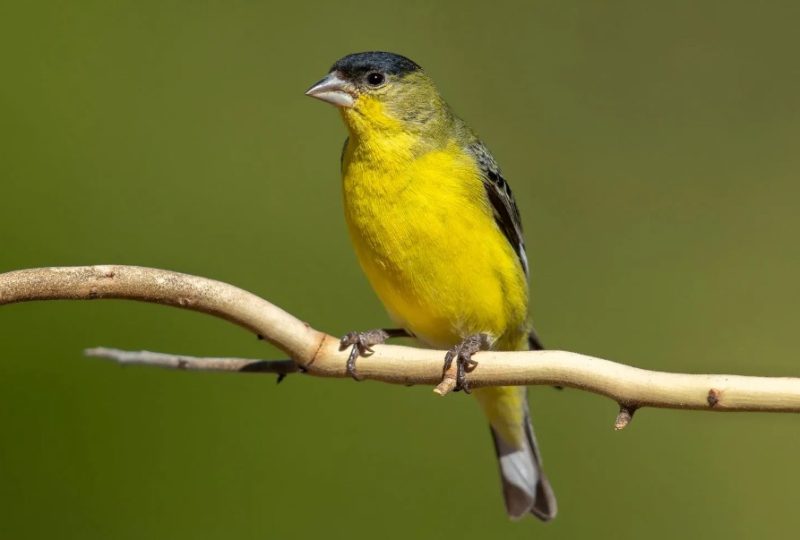
The Lesser Goldfinch is a tiny, energetic finch with a bright yellow belly and black or dark greenish back, depending on the region. Males have black caps and wings with white wing bars, while females are paler yellow with more subdued markings. Both sexes have short, notched tails and conical bills.
These birds are often seen in small, noisy flocks, bouncing from branch to branch or fluttering around feeders. They have a pleasant, twittering song and are quite agile as they feed on seeds from sunflowers, thistles, and other weedy plants. Lesser Goldfinches also enjoy nyjer seed feeders and can be seen hanging upside down as they eat.
Common in Southern and Central California, Lesser Goldfinches frequent suburban yards, parklands, and edge habitats with plenty of vegetation. They’re especially abundant in the foothills and open spaces around Los Angeles and San Diego, but they range into Northern California as well.
Western Bluebird (Sialia mexicana)
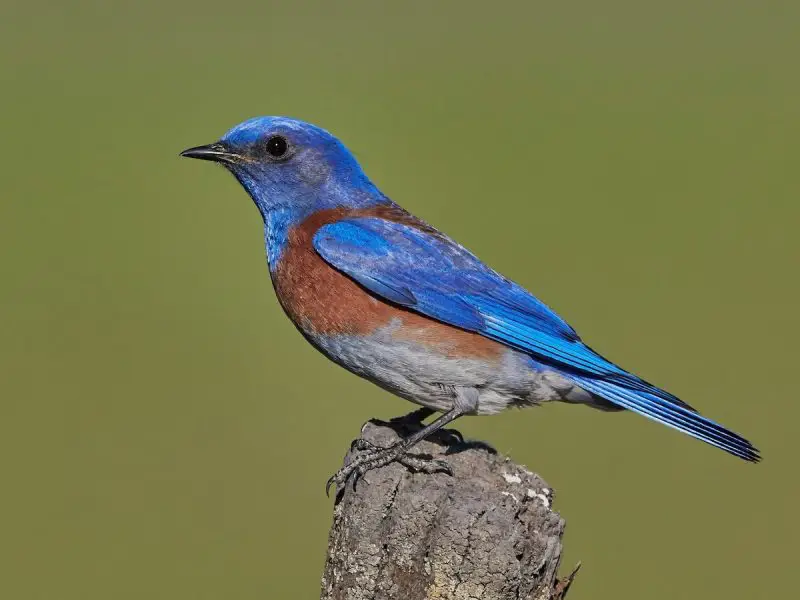
The Western Bluebird is a charming, medium-sized bird with deep blue plumage on the head, wings, and tail, and a rusty orange chest that fades into a gray belly. Females are duller but still show blue tones on their wings and tail. Their compact build and short, straight bill help distinguish them from other songbirds.
This species is known for its calm and gentle nature, often perching quietly on fence posts or low branches. Western Bluebirds feed mainly on insects and berries and are cavity nesters, often taking up residence in nest boxes or old woodpecker holes. Their soft warbling calls and melodious songs add a peaceful touch to any backyard.
They are frequently seen in open fields, orchards, and suburban gardens throughout California, particularly in areas with scattered trees or meadow-like habitats. From the Central Valley to the coastal foothills, Western Bluebirds are a welcome sight in both wild and human-made landscapes.
Mourning Dove (Zenaida macroura)
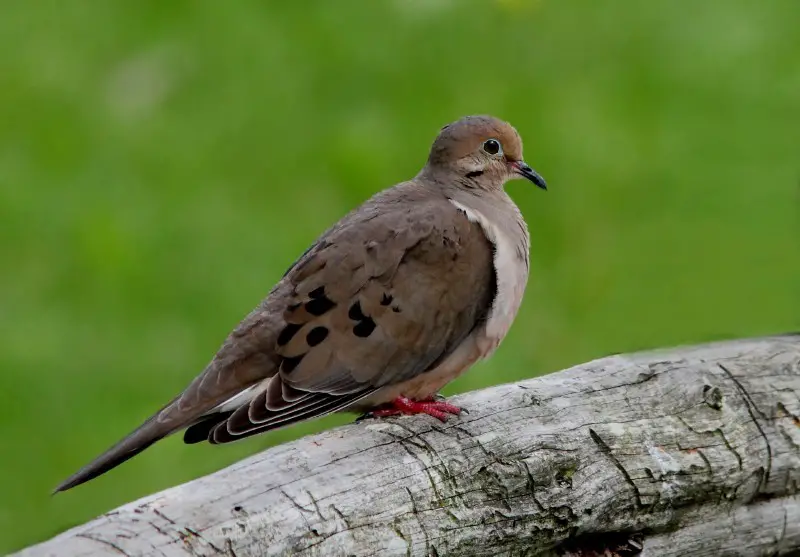
The Mourning Dove is a sleek, medium-sized bird with soft gray-brown plumage, a long pointed tail with white edges, and black spots on the wings. Its delicate appearance is matched by a small black bill, pinkish legs, and subtle iridescence on the neck. It has a graceful, streamlined shape and a calm demeanor.
This species is named for its gentle, mournful cooing sound, often heard in the early morning or late afternoon. Mourning Doves are ground feeders, frequently seen pecking at seeds on patios, driveways, and lawns. Their flight is swift and direct, accompanied by a distinctive whistling sound produced by their wings.
Mourning Doves are widespread across California, thriving in urban, suburban, and rural settings. They are especially common in backyards, parks, and open spaces from the coast to inland valleys and deserts. They readily visit ground-level seed feeders and are present year-round throughout the state.
Northern Mockingbird (Mimus polyglottos)
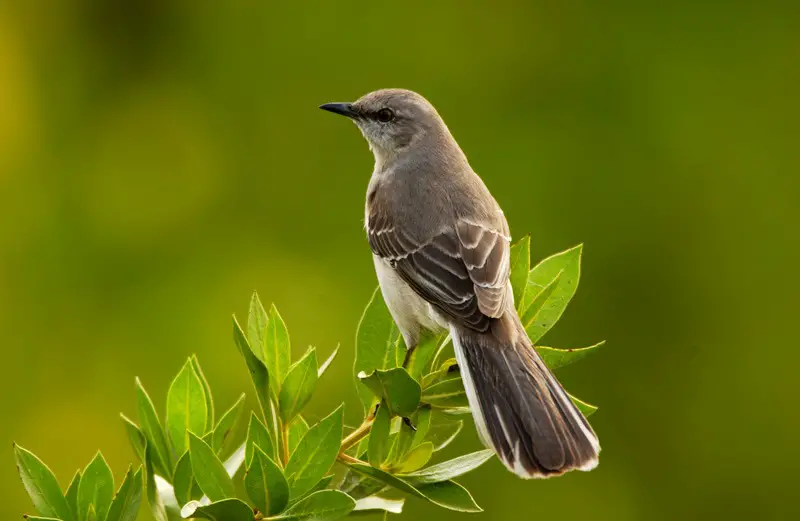
The Northern Mockingbird is a slender gray songbird with a long tail, white wing patches, and pale underparts. It has a slightly curved bill and long legs, giving it an alert, upright posture. Its striking white flashes in the wings and tail are especially noticeable in flight.
Famous for its ability to mimic the songs of other birds and even mechanical noises, the Northern Mockingbird is a relentless singer—often performing day and night. It’s a solitary and territorial bird, frequently seen perched on fences, rooftops, or treetops, especially while singing or keeping watch.
This bird is common in residential neighborhoods, city parks, and farmlands throughout California. From Los Angeles to San Francisco, it adapts well to both urban and semi-natural environments. Mockingbirds are year-round residents and are often among the most vocal and noticeable backyard birds in the state.
Oak Titmouse (Baeolophus inornatus)
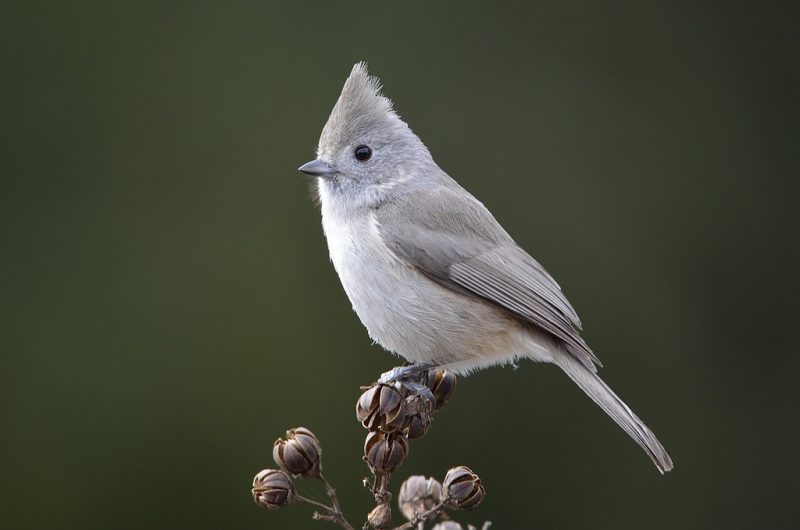
The Oak Titmouse is a small, compact bird with plain gray plumage, a pale belly, and a short crest that gives it a distinctive silhouette. Its lack of strong color contrasts makes it less flashy than other songbirds, but its energetic behavior makes it easy to spot once noticed.
These birds are active foragers, often seen hopping along branches or hanging upside down as they search for insects, seeds, and acorns. The Oak Titmouse is a regular visitor to backyard feeders, especially those offering sunflower seeds or suet. It has a rapid, chattering call that sounds like a mechanical “chee-chee-chee.”
This species is native to oak woodlands and is found primarily in central and northern California. It thrives in residential areas with native trees or mature gardens and is most common in the Coast Range and Sierra Nevada foothills. Unlike other titmice, it tends to remain in one area throughout the year.
Black Phoebe (Sayornis nigricans)
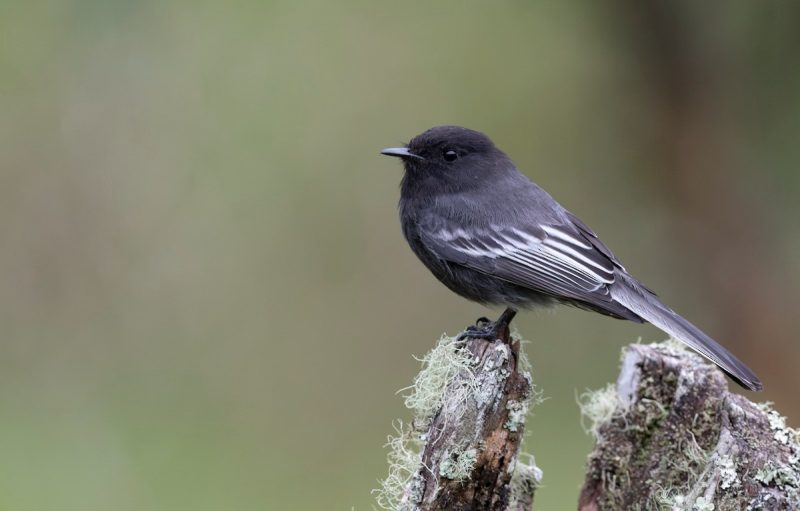
The Black Phoebe is a small flycatcher with striking black plumage contrasted by a clean white belly and undertail. It has a slightly rounded head, thin black bill, and long tail, which it frequently pumps up and down while perched. Its simple black-and-white coloration is very distinctive.
Known for its sit-and-wait hunting style, the Black Phoebe often perches low on fences, rocks, or branches near water or open areas. It darts out to catch flying insects mid-air, then returns to the same perch. Its sharp, chirpy call—often a sharp “chip-chip-chip”—adds to its alert personality.
This species is widespread in California, especially near creeks, fountains, birdbaths, and backyard ponds. It thrives in both rural and urban environments, from San Diego to the Bay Area. The Black Phoebe is a year-round resident and one of the few flycatchers commonly seen in winter.
American Crow (Corvus brachyrhynchos)
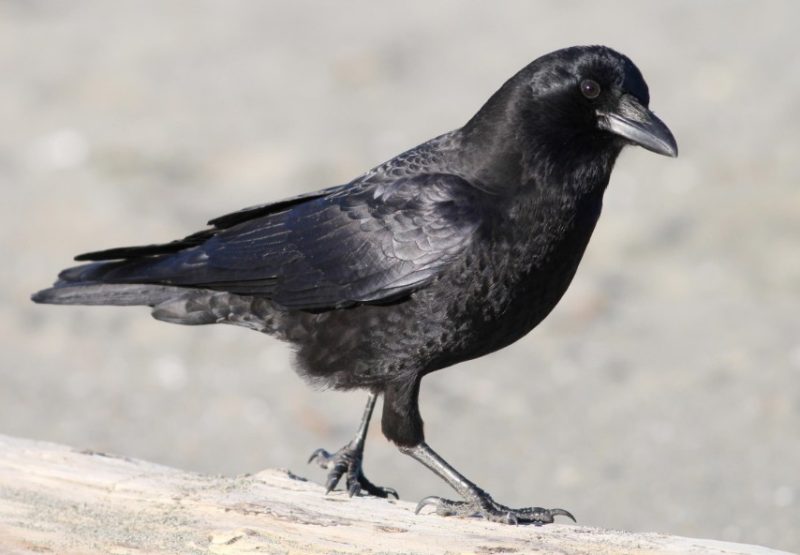
The American Crow is a large, glossy black bird with a strong bill, broad wings, and fan-shaped tail. Its feathers have a purplish sheen in sunlight, and it walks with a deliberate, confident gait. Its overall size and loud cawing make it hard to miss in any California neighborhood.
Highly intelligent and adaptable, crows exhibit complex social behavior, often seen in pairs or family groups. They forage on the ground for almost anything—seeds, insects, garbage, or small animals—and sometimes dunk food in water before eating. Crows are also known for using tools and playing with each other.
American Crows are widespread and common across California, from coastal cities and farmlands to forests and mountains. They are permanent residents and can be found in both heavily developed urban areas and open countryside. Their loud calls and social nature make them a familiar part of the backyard soundscape.
Dark-eyed Junco (Junco hyemalis)
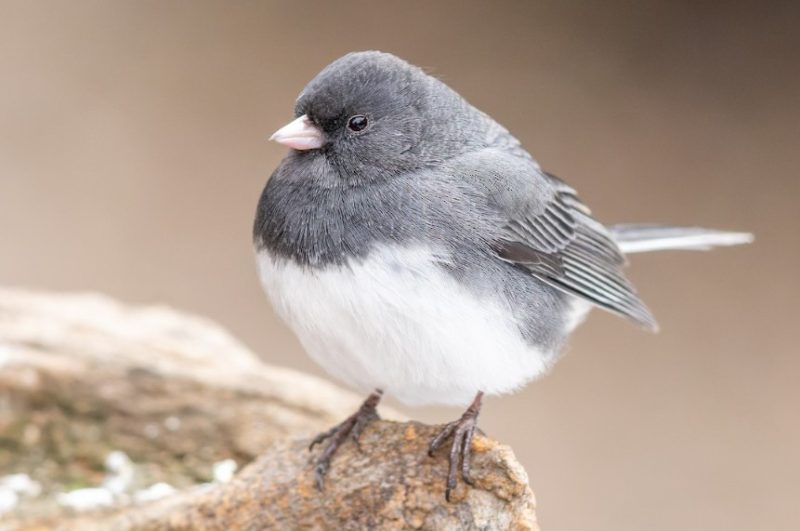
The Dark-eyed Junco is a small, round songbird with a short pink bill and a distinctive color pattern. Most individuals seen in California have slate-gray heads and backs, white bellies, and white outer tail feathers that flash as they fly. Variations exist depending on the region, but the contrast between dark upperparts and pale underparts is a key field mark.
These birds are ground feeders and are often seen hopping or scratching beneath feeders in winter, searching for seeds. Their movements are quick and deliberate, and they usually stay close to cover like low shrubs or garden beds. Their soft trills and ticking calls add a subtle presence to quiet winter backyards.
In California, Dark-eyed Juncos are primarily winter visitors in many lowland areas, especially from the Central Valley to coastal suburbs. In higher elevations such as the Sierra Nevada, they may nest and remain year-round. Backyard feeders with millet or sunflower seeds can attract them during colder months.
Spotted Towhee (Pipilo maculatus)
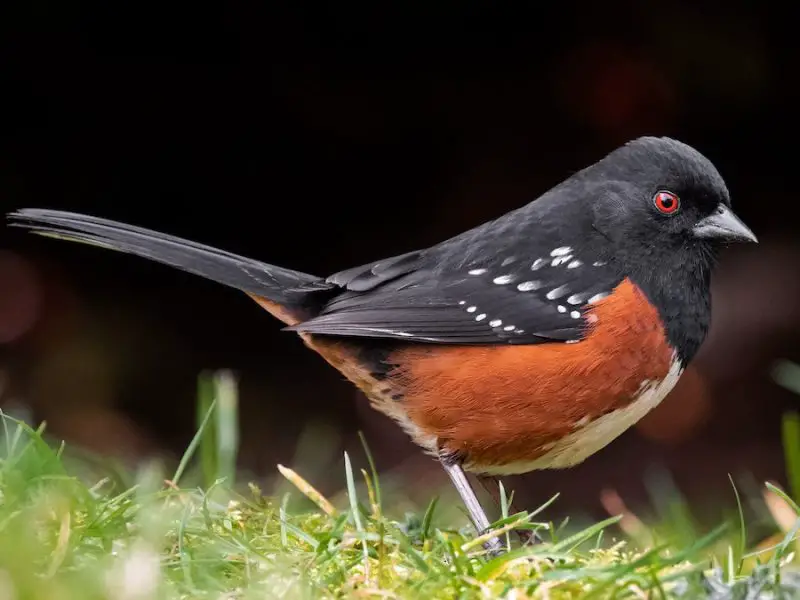
The Spotted Towhee is a large, striking sparrow with a jet-black head, back, and tail (in males), bold white spots on the wings, and rich rufous flanks. Females have a similar pattern but are slightly browner. Their red eyes and long tails add to their distinctive look.
These birds are most often seen on the ground, kicking up leaf litter with both feet in search of insects and seeds. They’re shy but vocal, with a harsh “chewink” call and a trilling song. Spotted Towhees prefer thick cover but will venture into open yards with dense shrubs or hedges.
They are found year-round in many parts of California, particularly in wooded edges, chaparral, and suburban gardens. From Southern California foothills to northern oak woodlands, Spotted Towhees are regular visitors wherever natural brushy habitat remains.
Bushtit (Psaltriparus minimus)
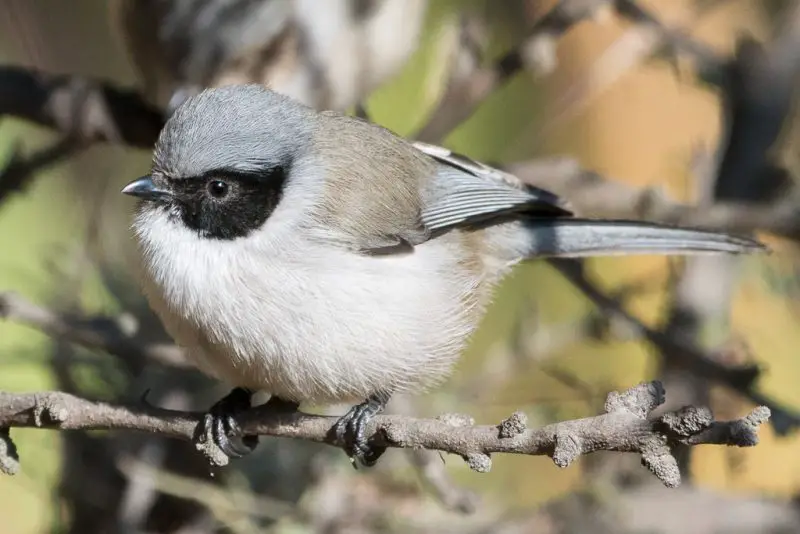
The Bushtit is one of the tiniest songbirds in California, with plain grayish-brown plumage, a short tail, and a tiny, stubby bill. Males and females look alike, though females have pale irises. Their size and constant motion make them easy to miss, but they’re rarely alone.
Bushtits move in tightly knit flocks, often 10 to 30 birds, chattering as they pass through trees and shrubs. They forage for insects, spiders, and tiny berries, hanging upside down and fluttering among twigs. Their presence is often betrayed by their high-pitched, buzzy calls.
Bushtits are common year-round in coastal and southern parts of California, including urban parks, oak woodlands, and backyard landscapes with dense foliage. They are particularly fond of native plants and mixed shrubbery, making them frequent visitors in well-planted gardens.
Red-winged Blackbird (Agelaius phoeniceus)
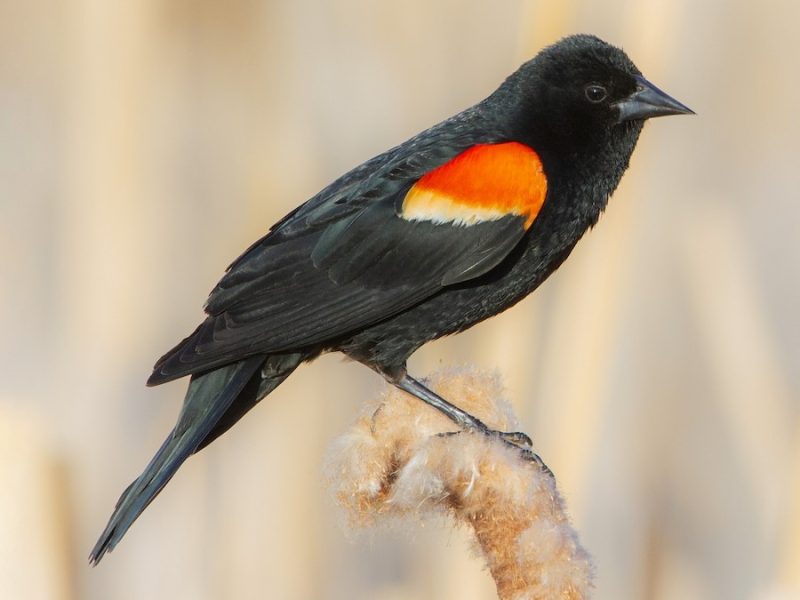
The male Red-winged Blackbird is easily identified by his glossy black body and bright red-and-yellow shoulder patches, which he flares during territorial displays. Females are heavily streaked brown and resemble large sparrows, helping them blend into marsh vegetation.
These birds are known for their musical “conk-a-ree” call and their preference for wetlands, but they also visit feeders, especially those offering cracked corn or seed mixes. Males can be seen singing from cattails, fences, or trees, guarding their nesting territory during spring and summer.
Red-winged Blackbirds are widespread across California, from marshes and irrigation ditches to suburban backyards near open fields. They are especially abundant in the Central Valley and along the coast, but they can be seen in nearly every part of the state during the breeding season.
European Starling (Sturnus vulgaris)
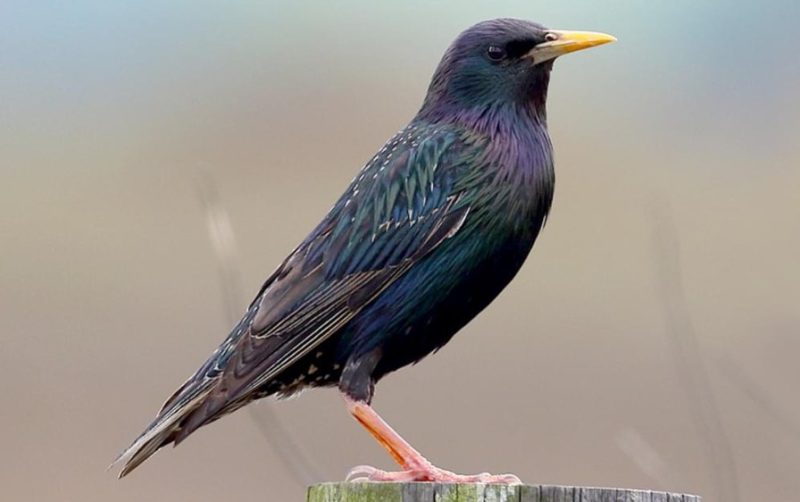
The European Starling is a stocky, medium-sized bird with glossy black plumage that shimmers with purple and green iridescence in sunlight. In winter, they show white speckles across their bodies, and they have yellow bills during the breeding season. Their short tails and pointed wings give them a distinctive flight silhouette.
Starlings are loud, gregarious birds that form large flocks and often dominate feeders. They are capable mimics and produce a variety of whistles, clicks, and buzzes. They often compete aggressively with native species for nesting sites and food, especially in urban environments.
Introduced from Europe, starlings are now common throughout California, particularly in cities, agricultural areas, and suburban neighborhoods. They are frequent visitors to suet feeders, lawns, and fruiting trees, where they can gather in noisy, swirling flocks during fall and winter.
Song Sparrow (Melospiza melodia)
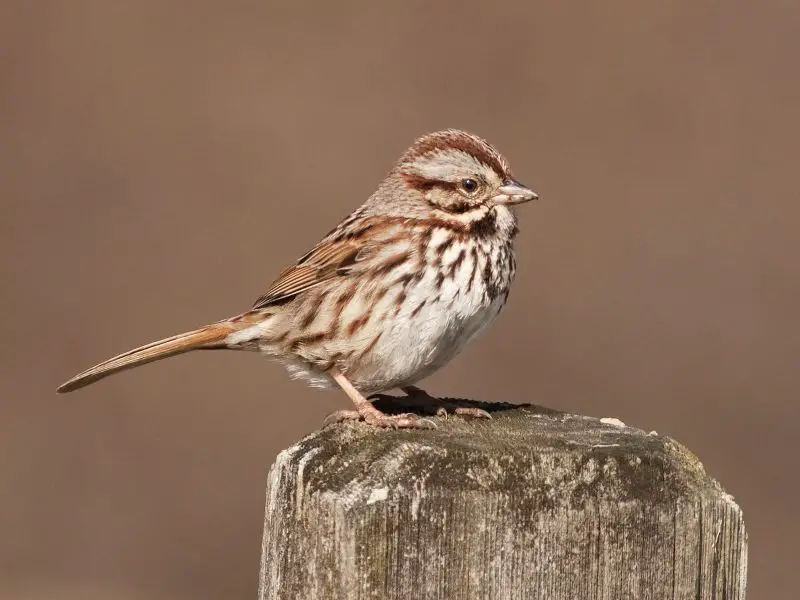
The Song Sparrow is a medium-sized sparrow with heavily streaked brown plumage and a rounded tail. Its most noticeable field mark is the set of dark brown stripes across its breast, often converging into a central spot. The bird has a gray face with a brown crown and a warm, buffy wash on its sides.
This sparrow is well known for its rich, melodic song, which varies by region and individual. Males sing persistently during the breeding season from exposed perches like fence posts and low branches. Song Sparrows often forage on the ground or in low vegetation, scratching through leaves for seeds and insects.
In California, Song Sparrows are found year-round in a wide range of habitats, including coastal wetlands, suburban backyards, and riparian areas. They are especially common near thickets, brush piles, and water features, where they find both shelter and food.
White-crowned Sparrow (Zonotrichia leucophrys)
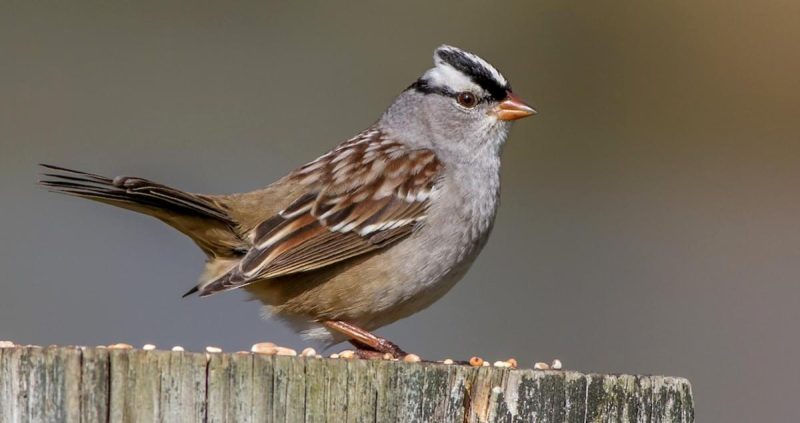
The White-crowned Sparrow is a striking songbird with a bold black-and-white striped head, gray face, and pale underparts. It has a long tail and a pink or yellow bill depending on age and region. Juveniles have a more subdued head pattern with brown and tan stripes.
These sparrows are especially vocal, producing a sweet, whistling song that’s heard frequently in winter and early spring. They often travel in small flocks and forage on the ground, scratching for seeds, grains, and insects near bushes and garden edges. Their behavior is generally calm and alert.
In California, White-crowned Sparrows are abundant winter visitors, especially along the coast and in the southern half of the state. They appear in backyards, parks, and open fields from fall to spring, then migrate north to breed in Alaska and northern Canada.
Western Tanager (Piranga ludoviciana)
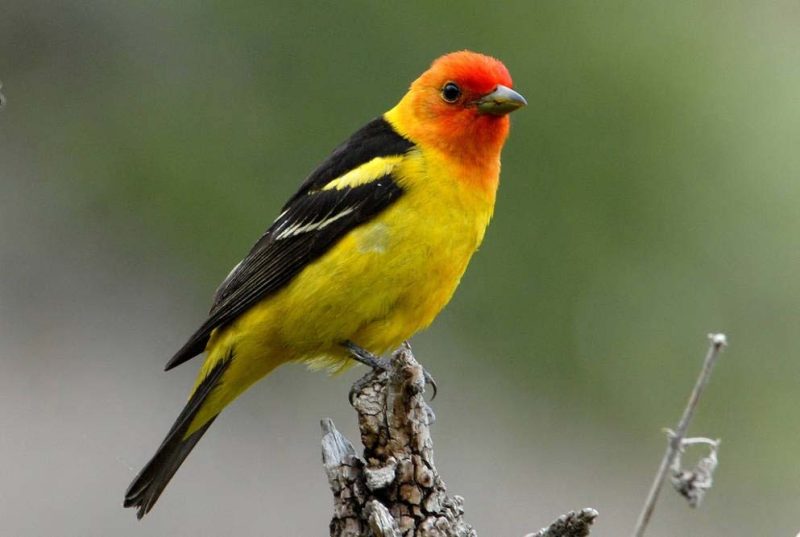
The male Western Tanager is a stunning bird with a bright yellow body, black wings with white bars, and a vibrant red-orange head during the breeding season. Females are duller, with greenish-yellow tones and a grayish head. Their sturdy build and thick bills give them a distinctive look.
Western Tanagers are quiet but active birds that prefer the treetops. They feed on insects and fruit, often gleaning food from foliage or catching insects in mid-air. Though they are not frequent feeder birds, they may visit if fruit or nectar is available.
These tanagers migrate into California during spring and summer, breeding in coniferous forests and wooded suburbs, especially in the Sierra Nevada, coastal ranges, and northern parts of the state. Their brilliant coloration and rarity in yards make them a prized sighting for many birdwatchers.
Bewick’s Wren (Thryomanes bewickii)
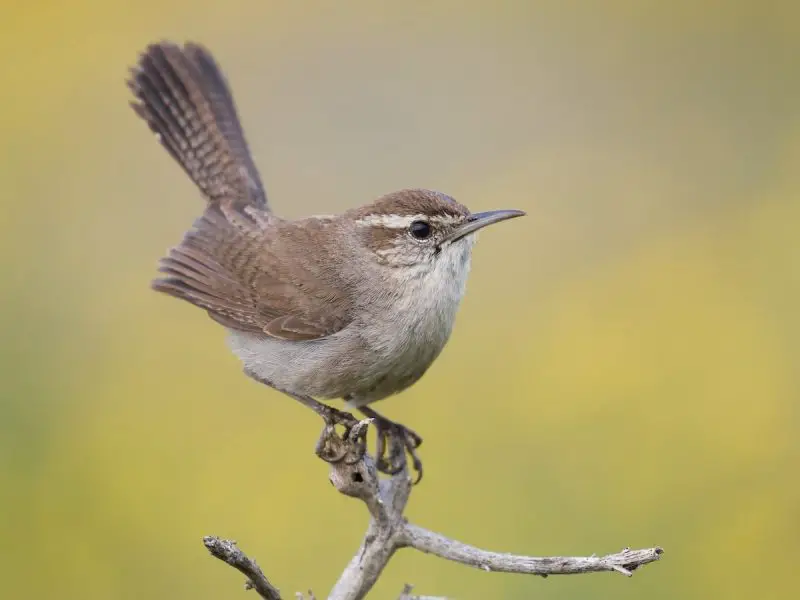
Bewick’s Wren is a small, lively bird with a long, cocked tail edged in white and fine barring. Its plumage is mostly brown-gray above and pale below, with a prominent white eyebrow stripe. The bird’s slim, curved bill is ideal for probing into crevices for insects.
These wrens are known for their bold personality and loud, bubbly song, often delivered from exposed perches. They are curious and agile, frequently seen hopping through dense shrubs, tangles, and brush piles. Their behavior is more noticeable than their plain coloring might suggest.
Bewick’s Wrens are year-round residents throughout much of California, especially in coastal and central regions. They are common in suburban gardens with dense vegetation, where they often nest in cavities or nest boxes close to the ground.
Steller’s Jay (Cyanocitta stelleri)
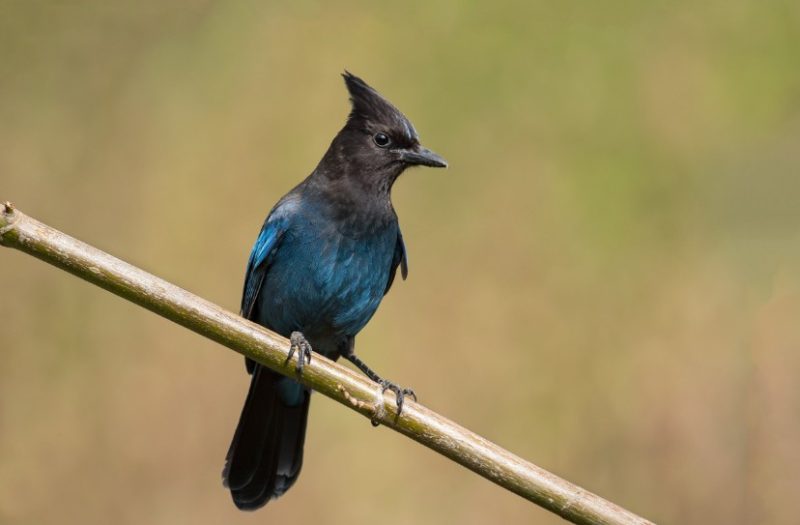
Steller’s Jay is a large, dramatic bird with deep blue body plumage and a blackish head and crest. The tall crest gives the bird a distinctive silhouette, especially when raised. The wings and tail are rich cobalt blue with darker barring.
This jay is bold and noisy, often alerting others with a harsh “shack-shack” call. It is highly intelligent and opportunistic, feeding on nuts, seeds, insects, fruit, and even scraps. Steller’s Jays often visit bird feeders, especially in wooded or mountainous backyards.
These jays are primarily found in montane forests of California, such as the Sierra Nevada and coastal ranges. However, they may descend into nearby towns and wooded suburbs, particularly during fall and winter in search of food. Their vivid colors and loud calls make them unforgettable backyard visitors.
Acorn Woodpecker (Melanerpes formicivorus)
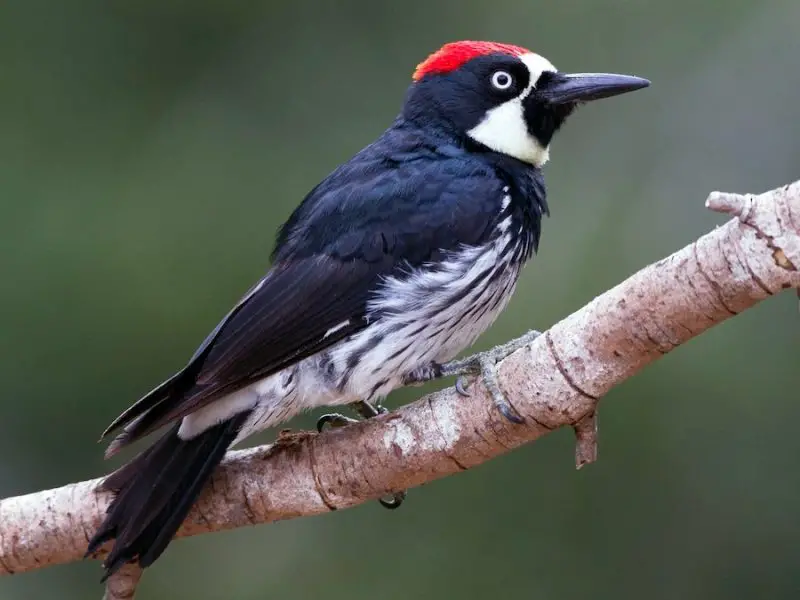
The Acorn Woodpecker is a striking bird with a bold white face, red cap, and black back and chest. Its eyes are pale and expressive, giving it a somewhat surprised look. Both sexes share the same vivid appearance, though males have slightly more red on their crowns.
This species is famous for its unique habit of storing acorns in holes drilled into tree bark, telephone poles, or wooden structures. These granary trees can hold thousands of acorns, and woodpeckers may spend months building and maintaining them. They live in social family groups and are quite vocal, emitting loud, laughing calls.
Acorn Woodpeckers are most common in oak woodlands and mixed forests across central and southern California. They are often seen in suburban neighborhoods with large oaks, where they may visit suet feeders or forage for insects and fruit. Their communal behavior and acorn-stashing make them one of California’s most fascinating backyard birds.
Northern Flicker (Colaptes auratus)
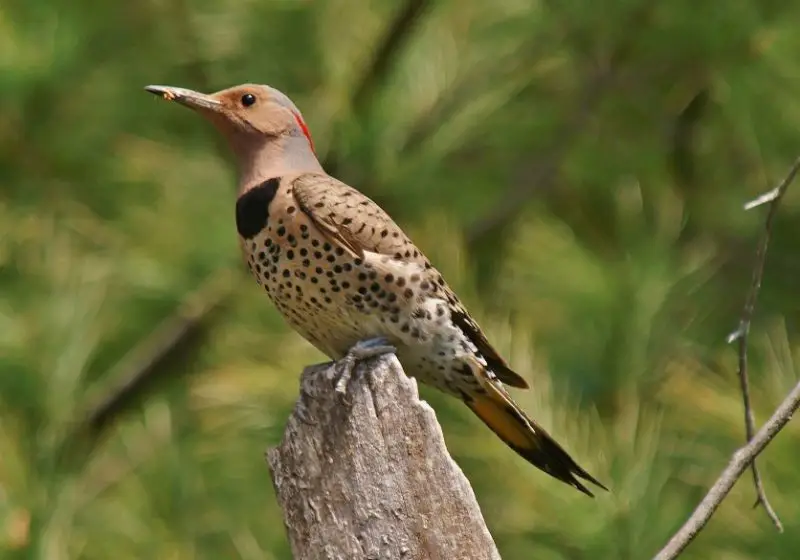
The Northern Flicker is a large woodpecker with a brownish body patterned in black spots and bars. In California, most flickers belong to the “Red-shafted” variety, showing red under the wings and tail, with a gray face and a red mustache stripe in males. Their white rump is noticeable in flight.
Unlike most woodpeckers, flickers often forage on the ground, especially on lawns and open dirt areas, where they dig for ants and beetles. Their call is a loud “kleer” sound, and their drumming on metal poles or trees is a common springtime sound.
Northern Flickers are found throughout California year-round, including in woodlands, city parks, and backyards. They’re especially visible in fall and winter when they explore open areas and may visit suet feeders or bird baths.
Wrentit (Chamaea fasciata)
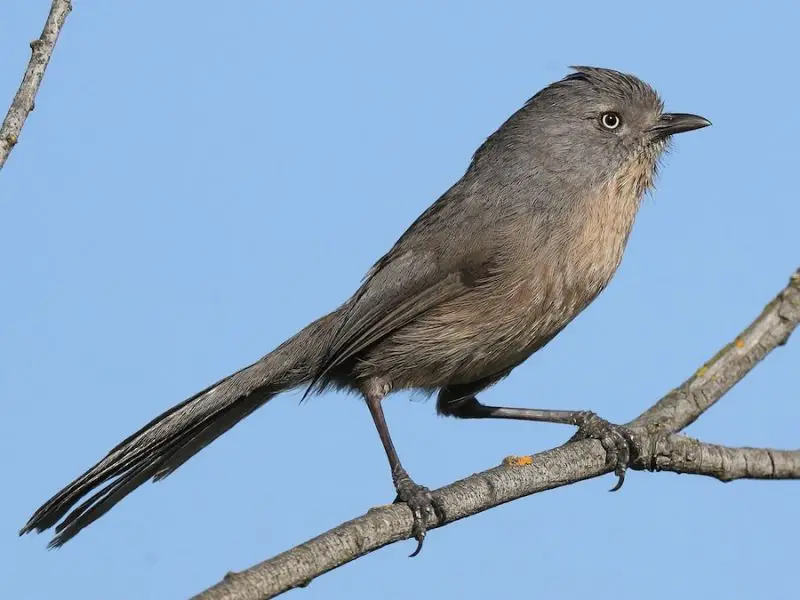
The Wrentit is a small, elusive songbird with soft brownish-gray plumage, a long tail often held at an angle, and pale eyes. Its appearance is subtle, but its behavior and voice make it easy to identify once heard. This species is the only member of its family found in North America.
Its call is a bouncing, ping-pong ball-like series of notes, often heard before the bird is seen. Wrentits are highly secretive, skulking through dense brush as they search for insects, berries, and seeds. They rarely stray far from cover, moving with short hops and low fluttering flights.
Wrentits are resident birds in the coastal scrub and chaparral of California, especially along the Central and Southern Coast. They occasionally visit brushy yards or untamed gardens near natural habitat, but they’re more often heard than seen.
Hooded Oriole (Icterus cucullatus)
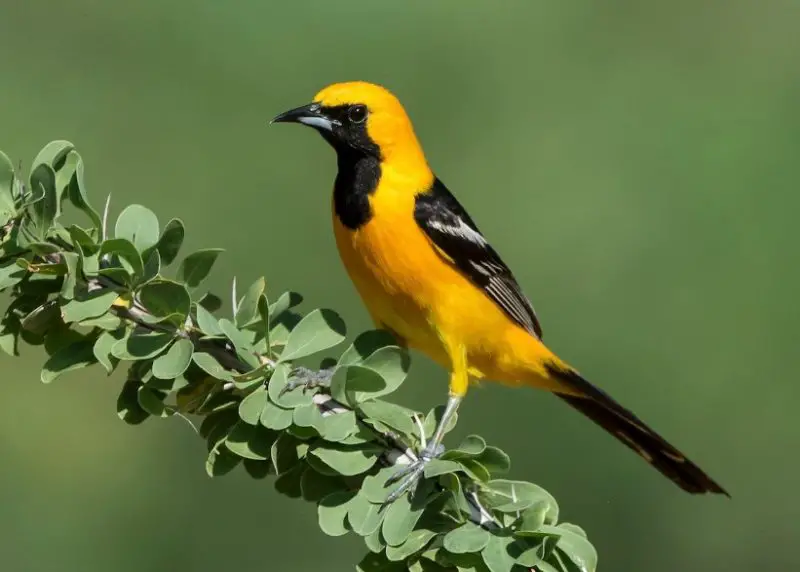
The Hooded Oriole is a vivid, tropical-looking bird with a bright orange-yellow body and a black face and bib in males. Females are duller yellow with a grayish back and less dramatic markings. Both sexes have long, curved bills and slim bodies.
These orioles are known for their unique hanging nests, often suspended from palm fronds. They feed on nectar, fruit, and insects, and readily visit hummingbird feeders or flowering trees. Their song is a mix of whistled notes and chatters, often given from high perches.
In California, Hooded Orioles are common spring and summer visitors in the southern and coastal regions. They return from Mexico in early spring and are often seen around ornamental palms and flowering plants in urban gardens and residential neighborhoods.
Yellow-rumped Warbler (Setophaga coronata)
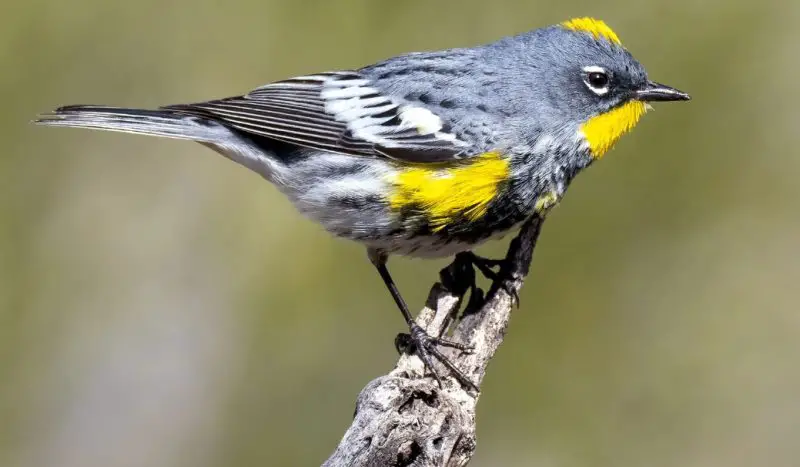
The Yellow-rumped Warbler is a small, energetic warbler with bluish-gray plumage, black streaks, and bright yellow patches on the rump, sides, and crown. There are two main forms: the “Audubon’s” variety found in the West, with a yellow throat, is most common in California.
This species is often seen flitting through trees and shrubs or flying out to catch insects mid-air. In winter, it switches to a diet that includes berries, making it more versatile than many warblers. Its sharp “chip” calls are a common sound in California gardens during the colder months.
Yellow-rumped Warblers are abundant winter visitors across California, from mountains to coast. They appear in forests, parks, and backyards, particularly where there are wax myrtle, juniper, or other berry-producing plants. In spring, many migrate north, but some may stay to breed in mountain forests.
Brown-headed Cowbird (Molothrus ater)
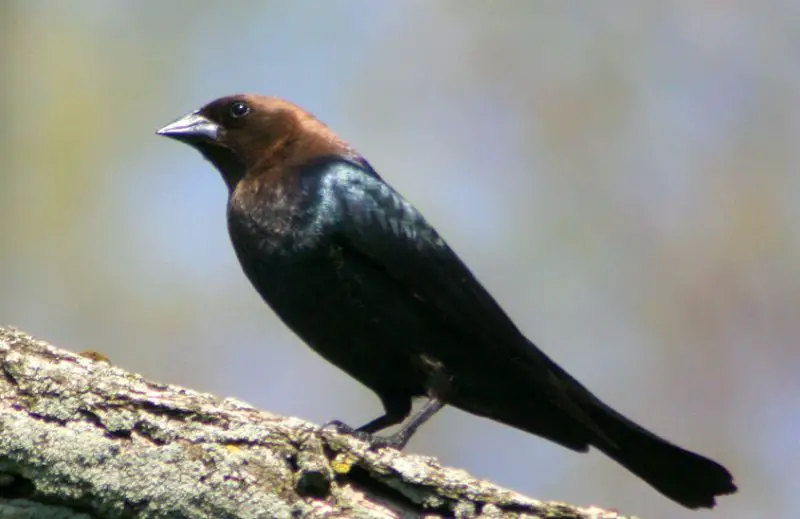
The Brown-headed Cowbird is a compact blackbird with glossy black plumage in males and a distinctive warm brown head. Females are more uniformly dull brown and streaked below, making them less conspicuous. Both sexes have a stout, conical bill suited for seed-eating and a short, squared tail.
Known for its brood‐parasitic behavior, the cowbird lays its eggs in the nests of other songbirds—often sparrows or warblers—leaving the unwitting foster parents to incubate and rear its young. In backyards, you’ll spot cowbirds foraging on the ground in flocks, probing soil and leaf litter for seeds and insects.
Brown-headed Cowbirds are widespread across California, favoring open or edge habitats such as lawns, pastures, and agricultural fields. They often accompany mixed flocks of sparrows and blackbirds near feeders, parks, and suburban gardens, particularly in the Central Valley and foothill regions.
American Robin (Turdus migratorius)
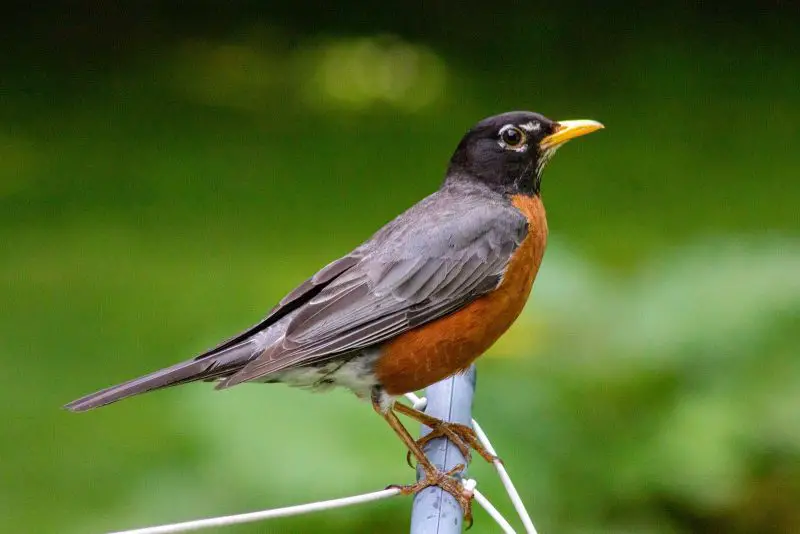
The American Robin is a familiar, plump songbird characterized by its brick-red breast, gray back, and white eye ring. Females are slightly paler below, but both sexes share the robin’s upright stance and long legs. Its round body and confident posture make it a common sight on lawns.
Robins feed primarily on earthworms and insects in grassy areas, often tilting their heads side to side as they hunt. In spring and summer, they switch to berries and fruits when available. Early in the morning, robins are among the first birds to sing, their clear, melodious caroling greeting the sunrise.
These migratory birds breed throughout much of California, nesting in trees, shrubs, or even on porch ledges. In winter, they often move to lower elevations and urban areas, remaining common in city parks, backyards, and golf courses across the state.
Cedar Waxwing (Bombycilla cedrorum)
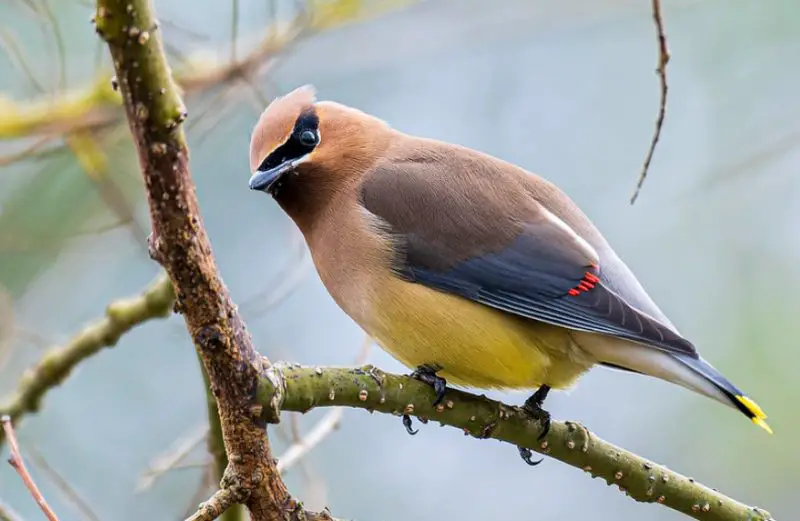
The Cedar Waxwing is a sleek, silky bird with soft brownish-yellow plumage that fades to pale gray on the wings and belly. A black eye mask bordered in white, bright red wax-like tips on the secondary wing feathers, and a yellow-tipped tail complete its elegant appearance. Both sexes look alike.
These social birds travel in small flocks, often seen perched quietly in fruiting trees or bushes. They feed heavily on berries—especially juniper, dogwood, and holly—and will also catch insects in flight. Cedar Waxwings pass fruit from bird to bird in a playful courtship behavior before eating.
In California, Cedar Waxwings are common winter visitors and summer breeders in woodland edges, suburban parks, and backyard landscapes with berry-producing shrubs. They range from coastal forests to inland foothills, but are most noticeable where ornamental or native fruiting plants are present.
Chipping Sparrow (Spizella passerina)
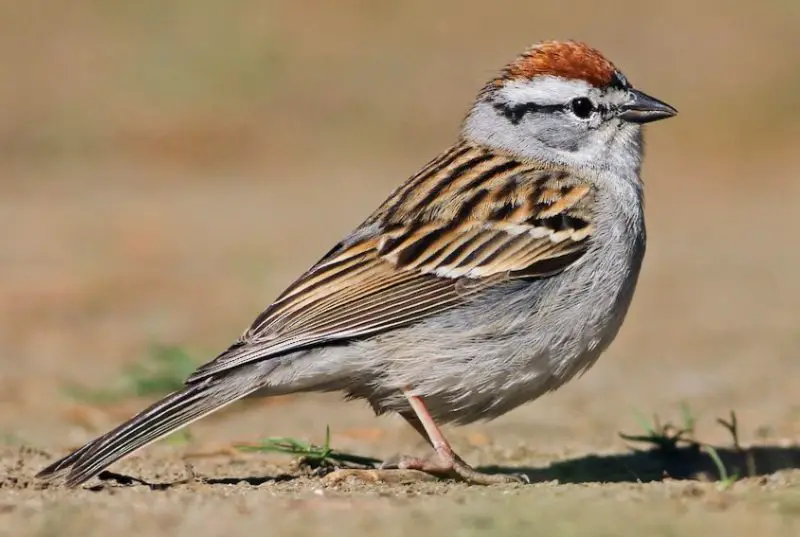
The Chipping Sparrow is a small, slender songbird with a bright cinnamon cap, gray face, and prominent black eye line. Its underparts are pale gray, and the back is finely streaked with brown. The clean plumage and bold head pattern make it relatively easy to identify at close range.
These sparrows forage on the ground or on low branches, picking up seeds, insects, and spiders. Their call is a rapid chip, given in flight and while perched. During the breeding season, males sing a crisp trill to establish territory, often from exposed perches such as wires or rooftops.
Chipping Sparrows breed throughout much of California’s open woodlands, parks, and suburban neighborhoods, especially in spring and summer. They favor habitats with scattered trees and open ground, including backyard gardens, orchards, and grassy clearings.
Allen’s Hummingbird (Selasphorus sasin)
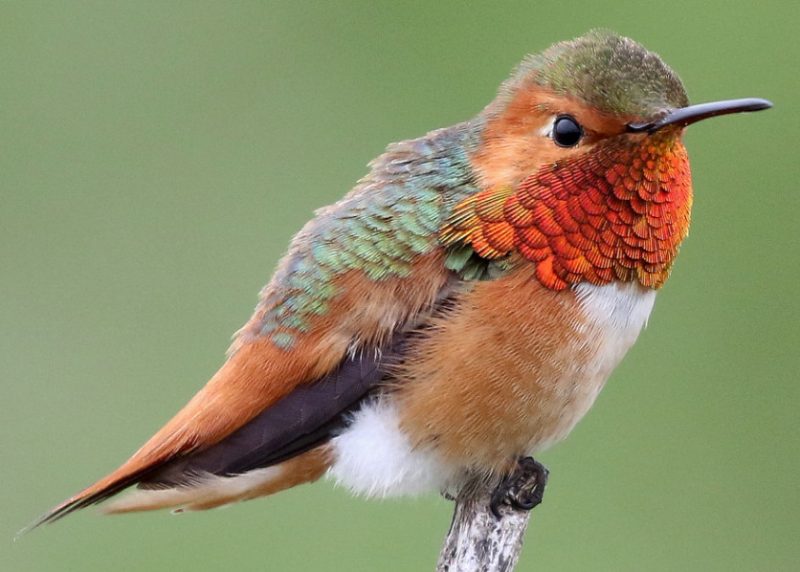
Allen’s Hummingbird is a petite, fast-moving bird with iridescent green upperparts and a brilliant orange-red throat patch in males. Females and juveniles lack the throat patch but show green backs, white underparts, and rufous flanks. Both sexes have a slightly curved bill tailored for nectar feeding.
This hummingbird aggressively defends nectar sources, darting between flowers and feeders with rapid wingbeats. Males perform dramatic dive displays during courtship, producing a high-pitched twitter. Their whirring calls and the faint buzz of their wings signal their presence in any garden.
Allen’s Hummingbirds are primarily found along the Southern California coast, from Big Sur down to Baja California. They are year-round residents in coastal scrub, gardens, and urban parks where flowering plants and feeders are abundant, making them a cherished sight in many backyards.
Nuttall’s Woodpecker (Dryobates nuttallii)
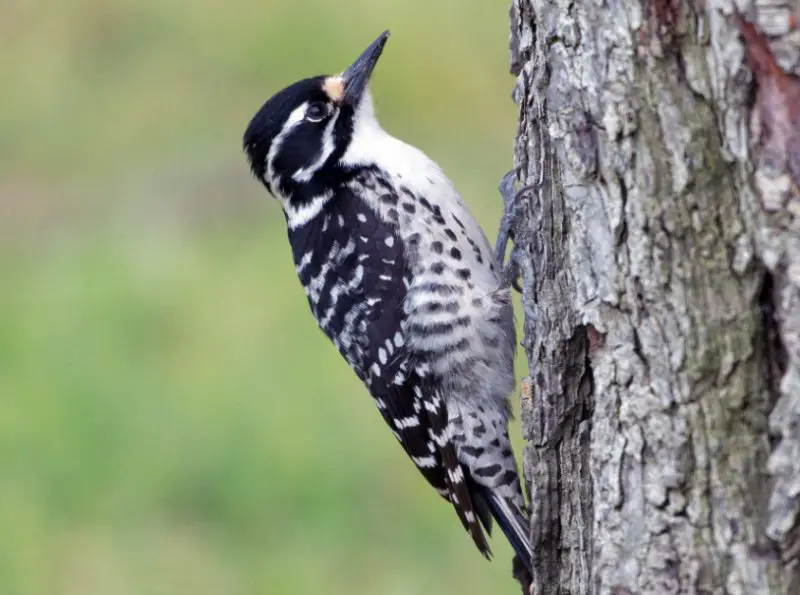
The Nuttall’s Woodpecker is a medium-sized woodpecker distinguished by its bold black-and-white barred back, clean white underparts, and a striking white moustachial stripe. Males sport a small red patch on the nape of the head, while females lack this red spot. Their sturdy bills and strong neck muscles allow them to hammer into oak bark in search of insects.
These woodpeckers forage actively on tree trunks and large branches, probing crevices for beetle larvae and ants. They often move in short, undulating flights between oaks, punctuating their search with sharp “pik” calls. Unlike some other woodpeckers, Nuttall’s favor horizontal trunk surfaces and may cling to the underside of limbs when feeding.
Endemic to California, Nuttall’s Woodpeckers inhabit oak woodlands from sea level up through foothills of the Coast Range, Sierra Nevada, and Transverse Ranges. They are common in suburban areas with mature oaks, where they may also visit suet feeders or come to birdbaths.
Townsend’s Warbler (Setophaga townsendi)
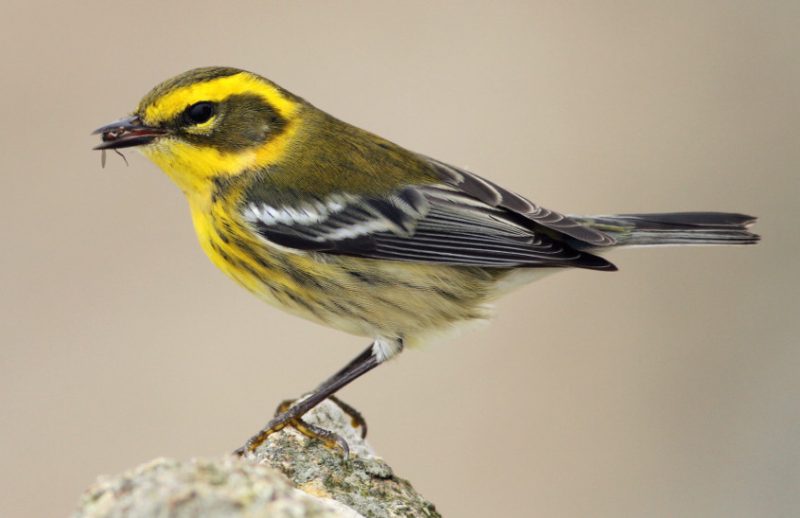
Townsend’s Warbler is a small, energetic songbird with olive-green upperparts, bright yellow underparts, and a bold black mask and throat patch. Males display vibrant coloration during the breeding season, while females and first-winter birds appear slightly duller but still retain the distinctive facial markings.
These warblers flit through conifer branches, gleaning insects from needles and bark crevices. Their song is a rapid, buzzy trill, often delivered high in the canopy. In winter, they may descend into mixed woodlands and even backyard plantings, where they can be coaxed to feeders with suet or insect-based offerings.
In California, Townsend’s Warblers are winter visitors along the coast and in foothill woodlands from Mendocino County southward. They favor mixed evergreen forests and often appear in riparian woodlands and residential areas with tall pines and cedars between November and March.
Say’s Phoebe (Sayornis saya)
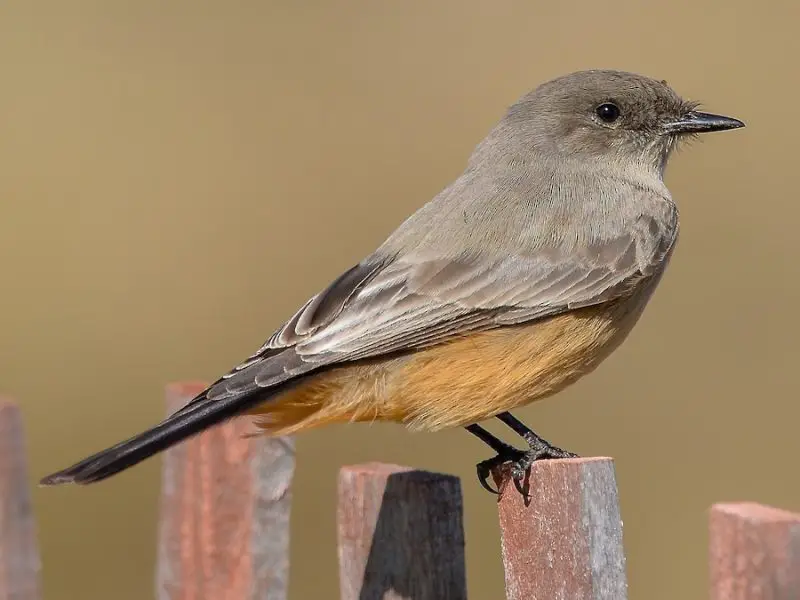
Say’s Phoebe is a slender flycatcher with a warm gray-brown back, pale underparts tinged with buff or orange on the belly, and a thin, pointed bill. Its tail is slightly notched and may be held cocked while perched. Both sexes look alike, though females may appear paler below.
This species hunts by sallying from perches such as fences, wires, or low branches, snapping up insects midair before returning to the same spot. Say’s Phoebes often wag their tails downward in a characteristic bobbing motion. Their call is a soft “chee-lick” and their song a sort of chiming warble.
Say’s Phoebes are common in open habitats throughout California’s lowlands and foothills, including suburban parks, farms, and desert edges. They particularly favor areas with scattered perches near open ground where flying insects are abundant, and they may nest on buildings, bridges, or rocky outcrops.
Golden-crowned Sparrow (Zonotrichia atricapilla)
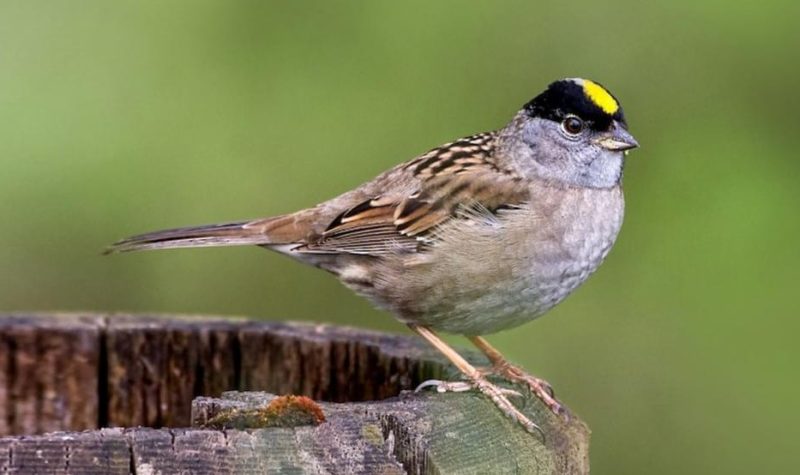
The Golden-crowned Sparrow is a plump songbird with a distinctive bright yellow crown bordered by black stripes, a gray face, and olive-brown upperparts. Its breast and belly are pale gray, and it has a short, conical bill ideal for seed eating. Females and juveniles show similar plumage but with less vivid yellow.
These sparrows forage on the ground or low vegetation, scratching and flicking leaf litter to uncover seeds and insects. Their clear, piping song—often transcribed as “oh-dear-me”—is frequently heard in winter flocks. They are relatively tame and may feed on patios, lawns, and ground-level feeders.
Golden-crowned Sparrows migrate through and winter in California, arriving in fall from northern breeding grounds. They are especially common along the coast and in foothill scrub and riparian zones from October through March. Small numbers sometimes linger into spring before heading north to breed.
Pine Siskin (Spinus pinus)
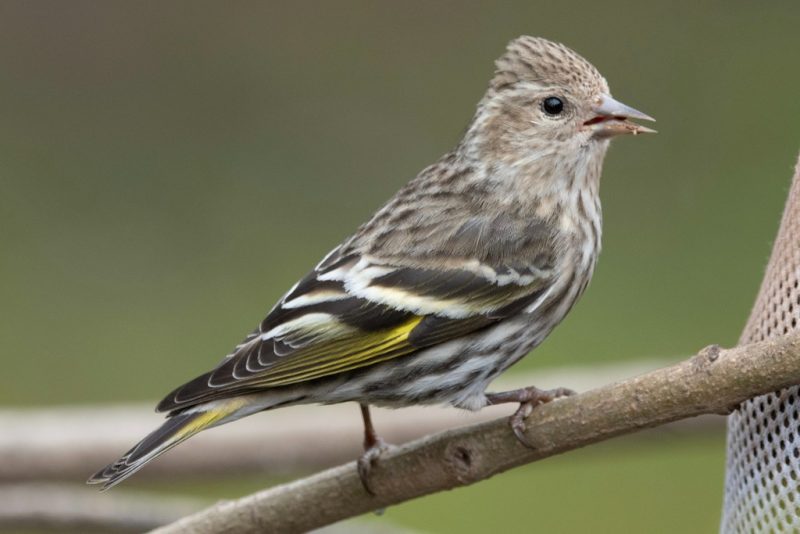
The Pine Siskin is a small finch with heavily streaked brown and buff plumage, accented by subtle yellow patches on the wings and tail. It has a slender, pointed bill and a sharply notched tail. Both sexes appear similar, though males may show slightly brighter yellow edging.
These energetic birds travel in flocks, foraging for seeds from conifers, weeds, and feeders. They cling nimbly to thistle (nyjer) feeders, extracting tiny seeds with precision. Their flight is characterized by rapid wingbeats and a distinctive “zzip” call given in flight or while perched.
In California, Pine Siskins are irregular winter visitors at backyard feeders, especially in pine-oak woodlands and montane areas. Their numbers fluctuate year to year with seed crops, but when present they may appear in large flocks from sea level to high elevations between November and April.
Frequently Asked Questions about Backyard Birds in California
What are some of the most common backyard bird species I might see in California?
California backyards frequently host species such as the California Scrub‑Jay, Anna’s Hummingbird, House Finch, Mourning Dove, and Dark‑eyed Junco. You may also encounter Oak Titmice in oak‑woodland areas, Black Phoebes near water, and European Starlings feeding on fruit.
How can I attract more birds to my backyard?
Providing a combination of native plants, bird feeders, and water sources will draw a wider variety of species. Nectar feeders attract hummingbirds like Anna’s and Allen’s, seed feeders appeal to finches and sparrows, and a shallow birdbath keeps doves and wrens coming back. Planting flowering shrubs and oak saplings supplies natural food and cover.
What types of feeders and food work best for California backyard birds?
Tube feeders filled with sunflower or mixed seeds are excellent for finches, sparrows, and scrub‑jays. Nyjer (thistle) feeders specifically attract Lesser Goldfinches and Pine Siskins. Nectar feeders suit hummingbirds, while suet cages lure woodpeckers, nuthatches, and Bushtits. Ground trays or platforms help ground‑foragers like Mourning Doves and Dark‑eyed Juncos.
When do migratory species arrive and depart California backyards?
Many warblers, such as the Yellow‑rumped and Townsend’s, appear in winter (November–March) along the coast and foothills. Western Tanagers and Hooded Orioles arrive in spring (April–May) to breed, then head north by late summer. Allen’s and Anna’s Hummingbirds defend territories year‑round along the coast but can wander inland in warmer months.
Are there any backyard birds that nest in man‑made structures?
Yes. House Finches commonly nest in eaves, hanging planters, and light fixtures. Bewick’s Wrens may use nest boxes or gaps under decks. Barn Swallows (occasional visitors) build mud nests on porch walls. Providing nest boxes designed for chickadees and bluebirds can also attract Western Bluebirds and Oak Titmice.
How should I maintain a bird‑friendly water source?
Keep birdbaths and small ponds clean by changing the water every 2–3 days and gently scrubbing algae. A dripper or small fountain adds movement that attracts Phoebes and Bushtits. In winter, ensure shallow basins don’t freeze; a birdbath heater can help. Position water near low shrubs for easy access and quick escape.
What native plants are best for supporting backyard birds?
Planting coast live oak, manzanita, toyon, and coffeeberry provides acorns, berries, and nesting cover for species like Acorn Woodpeckers, Spotted Towhees, and Cedar Waxwings. California lilac and buckeye attract insects for warblers and flycatchers. Native flowering plants such as penstemon and salvias supply nectar for hummingbirds.
How can I reduce hazards to birds in my backyard?
Place feeders close to cover (shrubs or small trees) so birds can escape predators. Keep windows visible by adding decals or netting to prevent collisions. Keep cats indoors or supervise them outside. Avoid using pesticides and herbicides that can poison insects and nectar sources vital to birds.
Do backyard birds need supplemental feeding year‑round?
Supplemental feeding is most beneficial in winter when natural food is scarce. During breeding season, native insects and berries provide ample nutrition. However, leaving feeders up year‑round gives birds a reliable food source when weather or habitat conditions change unexpectedly.
How do I identify the birds visiting my yard?
Keep a field guide or bird‑identification app on hand to match shapes, colors, and behaviors. Note key features: bill shape, wing bars, eye rings, and tail patterns. Observing feeding habits—like ground scratching versus hovering—also helps narrow down species. Consider setting up a camera or binoculars for closer study.


